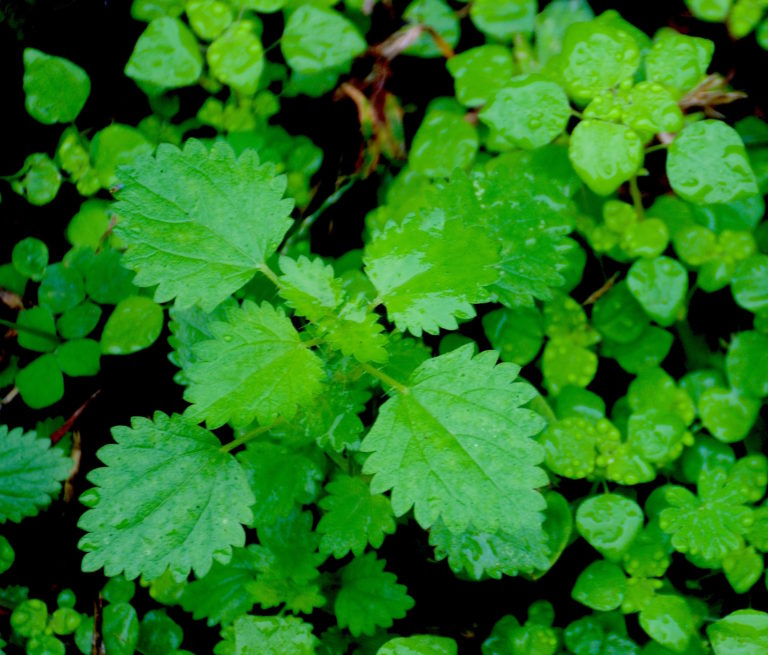
Stinging Nettles Urtica chamaedryoides, (Surrounded here by cucumber weed) are making their seasonal debut. Photo by Green Deane
Our mighty stinging nettles are up. They’re one of the most popular wild edibles.The most powerful stinging nettle is in New Zealand (Urtica ferox) which kills animals and has claimed at least one human life. Our nettle, Urtica chamaedryoides, has a sting like a giant wasp and can burn for days or more. While its common name is a deceptive, “Heartleaf Nettle” its botanical gets to the point, “Stinging Dwarf.” Quite edible but you must handle it with care (there are no stingers on the roots.) If this particular species stings me it is not only extremely painful but a welt develops and the site is sensitive to temperature changes and any liquid for more than a week. The irritant compounds are histamines and acetocholines. Apparently I am quite sensitive to them though I can eat the plant raw or cooked (crushing the needles disarms them.) Also don’t confuse this plant with another stinging plant called the Spurge Nettle, Cnidoscolus stimulosus (video here ). That has an edible root but the leaves are usually not eaten. To learn more about the Heartleaf Nettle go here. For a video, here.
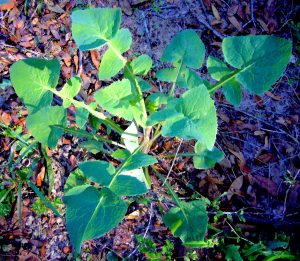
Common Sow Thistle. Photo by Green Deane
Another not unexpected seasonal green this week was the sighting of Sow Thistles in central and west Florida. Like its relative the Dandelion it, too, prefers the cooler months locally. Not a true thistle it’s one of the more milder seasonal greens. Although Sow Thistles are commonly called “thistles” they are not in the genus and do not draw blood like true thistles. True thistles are well-armed with needle-sharp spines. While the Sow Thistle can look intimidating it’s mostly just show in that the spines are soft. There are two species locally, the Common Sow Thistle and the Spiny Sow Thistle. The latter is a bit rougher than the former but no where near as abusive as true thistles. Both are slightly bitter raw. A few minutes of boiling or steaming takes away the bitterness completely (unlike wild lettuce which always stays slightly bitter.) I have a video on the sow thistles and to read more about them go here.
Foraging classes:Only one class this weekend, a long drive to south Florida, rain might be an accompaniment.
Saturday, February 3rd, Dreher Park, 1200 Southern Blvd., West Palm Beach, 33405. 9 a.m. to noon. Meet just north of the science center.
To read more about the classes, to pre-pay or sign up, go here.
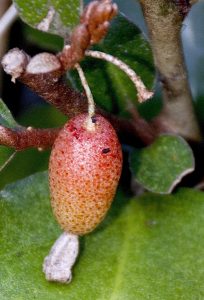
Silverthorn berries ripen in February.
Another seasonal species to be looking for is Silverthorn one of the few fruits that sets in our winter and is usually ripe about Valentine’s Day. That’s handy because the jelly-bean sized fruit is red with a gold netting or spray on it. But, if you remember the red fruit is ready around Valentine’s Day you’ll be looking for it. The boxy blossoms help you identify which shrubs — also called Ugly Agnes — will be producing fruit this year. It’s a common landscape plant and also an escapee. New fruit likes to grow on new growth and with waxy leave the species is fairly easy to identify. Even though the fruit is small it has the distinction of having the highest amount of the antioxidant lycopene per weight of any fruit. You can read about Silverthorn here and watch a video here.
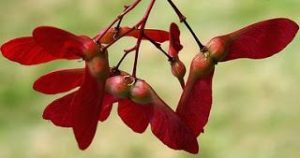
Tender Red Maple Seeds
If you look across local lakes now you will see ruby red splotches on the horizon. Those are maples putting on new leaves. Are maple leaves edible? Yes and seeds, too. Are they prime foraging food? Opinions vary. The delicate samaras (see left) happen to be red but they can also be green. Later the auto-rotating wings will turn brown. Locally the trees are so heavy with seeds they appear red from a distance. As for eating them what you need to do is taste them first. If they are not bitter you can tear off the wings and eat them raw though some folks eat the soft wings, too. If they are bitter they need to be cooked in boiling water, cooled, then tasted. They should be less bitter. You may have to boil them again. Non-bitter seeds can also be roasted or sun-dried. Some Native Americans sprouted the seeds for a treat. I do not know of any toxic maple seeds to humans but red maple (Acer rubrum) leaves and seeds are toxic to horses. That said I do recall we had two red maple intentionally planted in the barnyard. My father liked the looks of them. Our five horses — definitely leaves eaters — left them alone. To read more about maples go here.
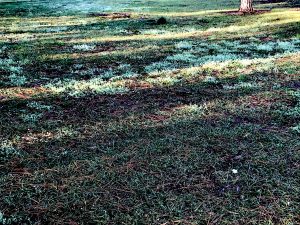
Patches of “white snow” on lawn. Photo by Green Deane
Drymaria cordata… Drymary… West Indian Chickweed… White Snow. Hopefully you can see in the accompanying picture why this species is called White Snow. When it is seeding and the sun hits the seed heads just right it can resemble a patch of white snow on your lawn. Unlike true chickweed, which is Stellaria media, Drymary is here most of the year but has similar uses to true chickweed (which you can also find now.) Young leaves and shoots are edible, older leaves have some medicinal uses including use as a diuretic. There is some research that suggests it can reduce coughing and can easy anxiety. You can read more about Drymary here.

You get the USB, not the key.
172-video USB would be a good end of spring present and is now $99. My nine-DVD set of 135 videos has been phased out. The USB videos are the same videos I have on You Tube. Some people like to have their own copy. Most of the 172 USB videos have to be copied to your computer to play. If you want to order the USB go to the DVD/USB order button on the top right of this page. That will take you to an order form.

Green Deane Forum
Want to identify a plant? Perhaps you’re looking for a foraging reference? You might have a UFO, an Unidentified Flowering Object, you want identified. On the Green Deane Forum we — including Green Deane and others from around the world — chat about foraging all year. And it’s not just about warm-weather plants or just North American flora. Many nations share common weeds so there’s a lot to talk. There’s also more than weeds. The reference section has information for foraging around the world. There are also articles on food preservation, and forgotten skills from making bows to fermenting food.
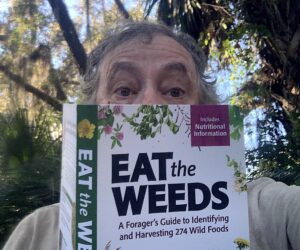
Finally, a physical copy of the book.
Now in print is EatTheWeeds, the book. It has 275 plants, 367 pages, index, nutrition charts and color photos. It’s available in many locations including Amazon. Most of the entries include a nutritional profile. It can also be ordered through AdventureKeen Publishing.
This is weekly newsletter #585. If you want to subscribe to this free newsletter you can find the sign-up form in the menu at the top of the page.
This is weekly newsletter #586. If you want to subscribe to this free newsletter you can find the sign-up form in the menu at the top of the page.
To donate to the Green Deane Newsletter click here.

White mexican poppy, Argemone albiflora. Photo by Green Deane
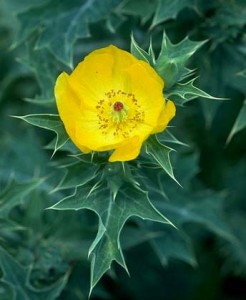
Yellow Mexican Poppy, Argemone mexicana, photo by Green Deane
No, it’s not edible. Depending on the weather I receive numerous emails wanting me to identify a white- or yellow-blossomed extremely prickly plant. It’s almost always a Mexican Poppy. Some years they bloom as early as Christmas or can still be blossoming in May. They are found in dry areas in much of eastern North America avoiding some north mid-west states and northern New England. Highly toxic, the Mexican Poppy tastes bad and is so well-armed that accidental poisonings amongst man or beast are few. The plants also that do not want to be eaten. However people have tried to use their seeds for cooking oil resulting in severe edema (water retention.) Herbalists, however, use the plants extensively (which brings up the importance of knowing what you’re doing.) Toxicity reportedly occurs only when large quantities are ingested and the plants might have had primitive uses in treating malaria. In one study the White Mexian Poppy helped three quarters of the patients but did not completely get rid of the parasitic load. The most common places to see the very prickly plants are beside roads and railroad tracks. The yellow seed oil, called katkar oil, can cause epidemic dropsy, particularly with severe leg swelling. It has also has been used in oil lamp for lighting.
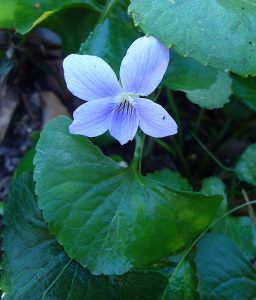
Violet Photo by Green Deane
A common blossom now that’s easy to identify is the wild violet. It’s cultivated brethren is the pansy. There are a huge variety of violets in North America ranging from field pansies to those that like to grow down hill from the septic tank. Whether wild or cultivated violets are attractive, personable blossoms, usually on the sweet, viscous side. There are a couple of precautions, however. The first is to make sure the soil they are in — either a pot or bed — is wholesome and that the water they are getting is good. Where I grew up “Johnny Jump Ups” (viola tricolor) were routinely picked from the septic tank’s drain field. If they come from a garden center they might have pesticides on them. The other precaution is a bit more esoteric: Yellow blossoms tend to have a laxative effect. You can read about violets here. I have a video about them here.

